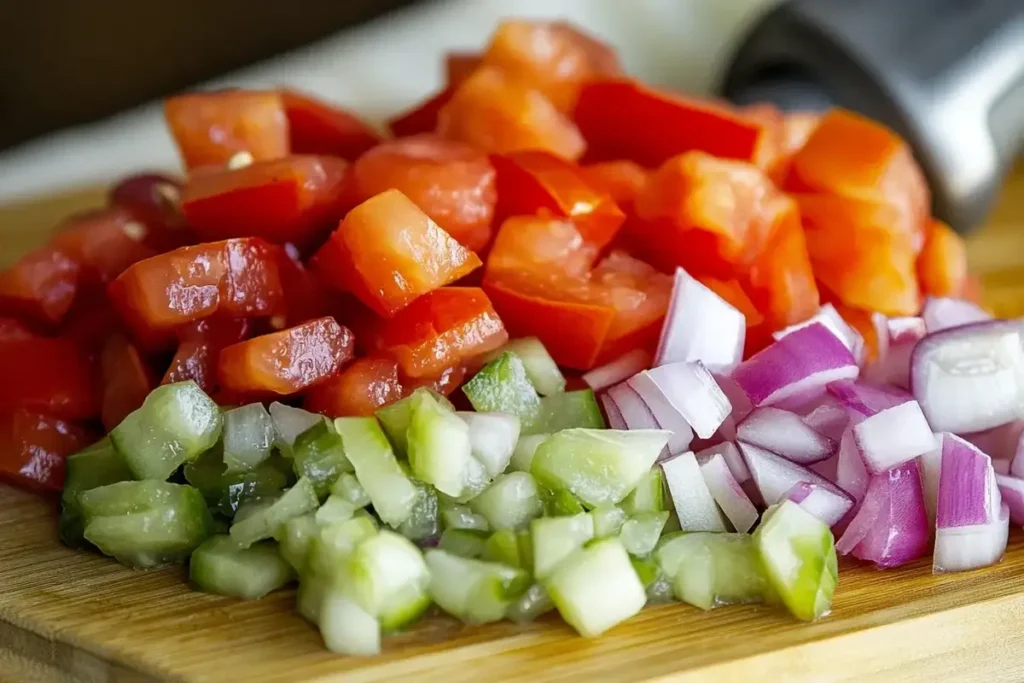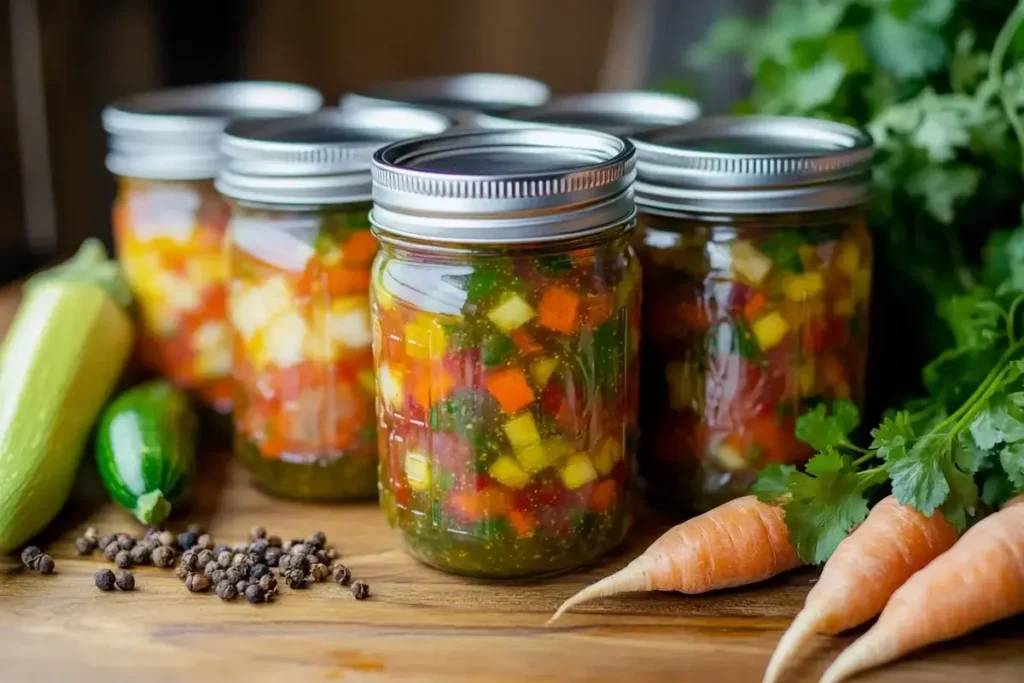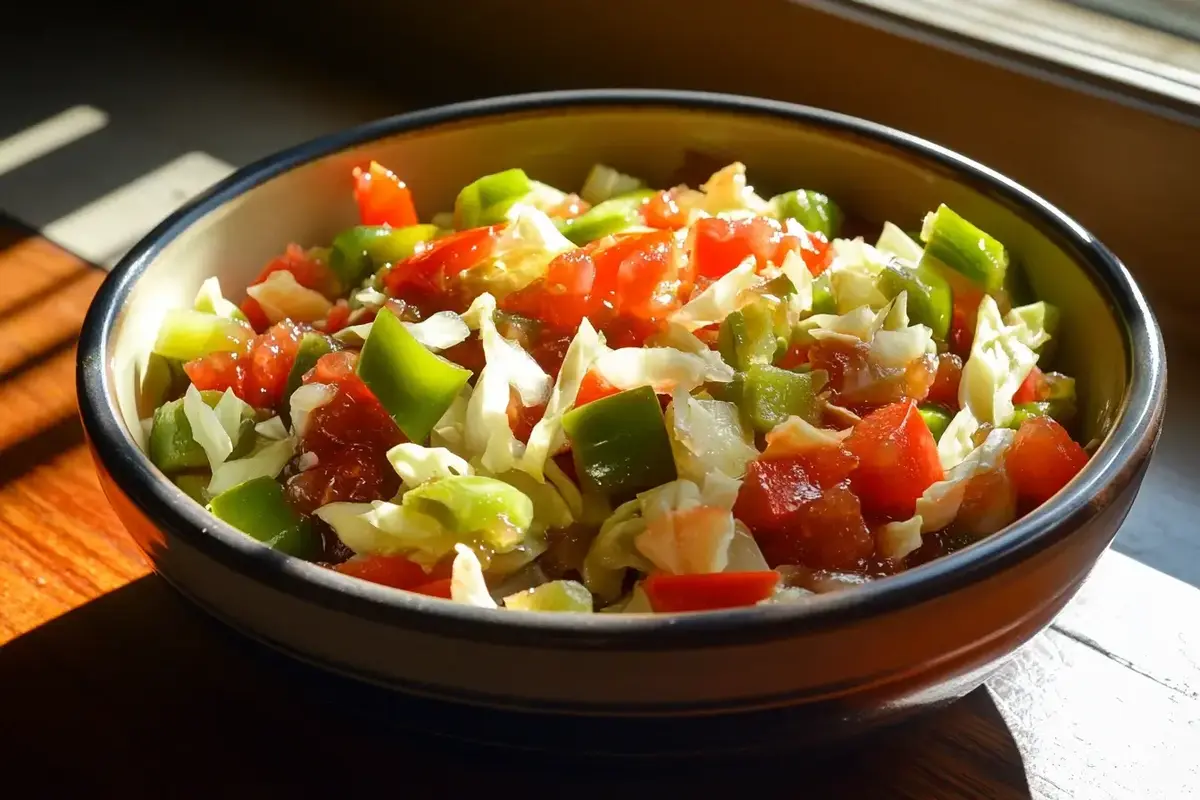Chow chow is more than just a colorful relish—it’s a beloved staple of Southern kitchens. Indeed, with roots deep in Appalachian cuisine and a history as rich as its flavors, chow chow has become a cultural icon in the South. Furthermore, from its unique preparation methods to its surprising versatility in Southern dishes, this tangy medley of pickled vegetables brings a burst of flavor wherever it goes. Therefore, this article dives into the origins, recipes, and culinary traditions behind this quintessential Southern relish. Now, let’s begin with its fascinating history.
Historical Origins of Southern Chow Chow
The question what is chow chow in the South often leads us to its historical roots. This relish, tied to Appalachian traditions, emerged as a way to preserve surplus vegetables.
How Chow Chow Came to the South
If you’ve ever wondered, what is chow chow in the South?, its origins trace back to early settlers who brought food preservation techniques from Europe and Asia. Pickling vegetables was a necessity in the days before refrigeration, and the South adopted this method to create its own unique version of this tangy condiment. Over time, chow chow evolved into a traditional Southern pickled relish with an unmistakable taste.
Appalachian Influence on Chow Chow
In the Appalachian Mountains, families relied on seasonal harvests to create green tomato relish and other preserved foods that could last through harsh winters. Chow chow became a favorite because it utilized end-of-season vegetables that might otherwise go to waste. This thrifty practice gave it a special place in Appalachian homes.
Cultural Significance Through Generations
Chow chow is more than just a recipe—it’s a family tradition passed down through generations. During gatherings, you’ll often hear stories of grandparents canning jars of Southern chow chow to share with neighbors. Today, it remains a symbol of Southern hospitality and ingenuity.
Key Ingredients in Traditional Southern Chow Chow
When exploring what is chow chow in the South, understanding its key ingredients is crucial.
Core Vegetables in Southern Chow Chow
The backbone of Southern chow chow lies in its fresh and colorful vegetables. Traditionally, the recipe includes:
- Green tomatoes – Often used for their tangy and slightly firm texture.
- Bell peppers – A mix of green and red peppers adds both flavor and visual appeal.
- Onions – Sweet or yellow onions enhance the relish’s savory depth.
- Cabbage – Shredded cabbage brings texture and crunch to the mix.
- Carrots – These add subtle sweetness and a vibrant pop of orange.
Essential Seasonings and Spices
Chow chow gets its iconic flavor from a blend of carefully chosen spices, such as:
- Apple cider vinegar – The tangy base that balances the sweetness.
- Mustard seeds – For a slight punch of spice and crunch.
- Celery seeds – Adds a delicate earthy undertone.
- Turmeric – Gives chow chow its warm yellow hue and mild peppery notes.
- Sugar – Balances the tartness of the vinegar while enhancing the natural sweetness of the vegetables.
Regional Variations in Ingredients
Depending on the region, the ingredients might vary slightly. For example, in some parts of the South, you’ll find hot peppers or green beans incorporated for a spicier version. Specifically, Southern Appalachian chow chow often uses an extra dose of red pepper flakes for a bold kick.
Preparation Methods for Authentic Southern Chow Chow

Step 1: Preparing the Vegetables
The first step in making authentic Southern chow chow is preparing the vegetables:
- Wash and chop – Rinse all vegetables thoroughly, and finely chop green tomatoes, bell peppers, onions, carrots, and cabbage. Uniformity in size is key to ensuring even pickling.
- Salt the mix – Sprinkle kosher salt over the chopped vegetables and let them sit for a few hours or overnight. This step helps draw out excess moisture, enhancing the texture of the final relish.
- Drain and rinse – After the vegetables have released their water, rinse them thoroughly and pat them dry to remove any excess salt.
Step 2: Cooking the Chow Chow
Next, combine the vegetables and spices in a large pot:
- Mix the vinegar and sugar – In a saucepan, stir together apple cider vinegar and sugar until dissolved. Add mustard seeds, celery seeds, turmeric, and any additional spices like crushed red pepper flakes.
- Simmer with vegetables – Add the drained vegetables to the vinegar mixture. Cook over medium heat, stirring occasionally, for about 30–40 minutes until the vegetables are tender and infused with the pickling liquid.
Step 3: Canning and Preserving
- Sterilize jars – Boil mason jars and lids to ensure they’re clean and ready for storing the chow chow.
- Fill the jars – Carefully ladle the hot chow chow mixture into the jars, leaving about ½ inch of headspace.
- Seal and process – Secure the lids and process the jars in a boiling water bath for 10–15 minutes.
- Cool and store – Allow the jars to cool, then store them in a cool, dark place. Properly canned chow chow can last up to a year.
Regional Variations of Chow Chow in the Southern United States
Answering what is chow chow in the South also means looking at its regional variations.
The Appalachian Twist
In the Appalachian region, chow chow takes on a unique identity. This version often includes more heat, with spicy peppers and red pepper flakes playing a central role. Additionally, some Appalachian recipes include string beans or corn for added texture, reflecting the resourcefulness of mountain communities.
Louisiana’s Creole Influence
In Louisiana, Southern chow chow incorporates flavors inspired by Creole cuisine. For instance, the addition of bold seasonings like paprika and cayenne gives the relish a zesty punch, making it a popular accompaniment to fried fish or gumbo. Moreover, this variation highlights the fusion of Southern and French culinary traditions.
The Carolinas’ Sweet Touch
Chow chow from the Carolinas tends to lean on the sweeter side, with higher sugar content balancing the tang of the vinegar. In particular, this version often pairs with barbecue dishes, where its sweetness complements smoky flavors. Additionally, Carolina chow chow may include extra cabbage for a crunchy, slaw-like texture.
Texas-Style Chow Chow
Everything’s bigger in Texas, and their chow chow is no exception. For instance, this variation frequently includes jalapeños and hot chili peppers, making it a fiery addition to brisket and other grilled meats. In addition, Texas-style chow chow incorporates larger vegetable chunks, thus reflecting the state’s bold culinary personality.
Why Regional Variations Matter
These regional differences demonstrate the versatility of chow chow. For example, each area of the South has added its own twist to this beloved relish, thereby creating a diverse tapestry of flavors that represent local preferences and traditions.
Nutritional Profile and Health Benefits of Chow Chow
Low-Calorie and Nutrient-Dense
Chow chow in the south is a guilt-free addition to your plate. Packed with vegetables like green tomatoes, bell peppers, cabbage, and carrots, it provides essential vitamins and minerals while remaining low in calories. A typical serving contains:
- Vitamin C – Boosts immunity and supports skin health.
- Fiber – Aids digestion and promotes gut health.
- Antioxidants – Found in turmeric and vegetables, these combat free radicals and reduce inflammation.
A Probiotic Boost (When Fermented)
Although not all chow chow recipes are fermented, some Southern variations allow the vegetables to undergo a light fermentation process. Fermented chow chow contains probiotics, which are beneficial for gut health and can enhance digestion.
Vinegar’s Health Benefits
The apple cider vinegar used in chow chow brings additional perks:
- Regulates blood sugar – Studies suggest that apple cider vinegar can improve blood sugar levels, particularly after meals.
- Supports heart health – Its acetic acid content may help reduce cholesterol and triglyceride levels.
Low in Fat but Big on Flavor
For those looking to cut down on unhealthy fats without sacrificing flavor, chow chow serves as a healthy alternative to calorie-dense condiments like mayonnaise or creamy dressings.
Customizable for Dietary Needs
With minor tweaks, chow chow can cater to specific dietary preferences. For example:
- Use less sugar or a natural sweetener for a low-sugar version.
- Opt for gluten-free spices and ingredients to accommodate gluten sensitivities.
Preserving and Storing Homemade Chow Chow

Why Proper Preservation Matters
Homemade chow chow can last for months or even years if stored correctly. Proper preservation ensures that the relish retains its flavor, texture, and safety for consumption. Plus, a well-sealed jar of chow chow makes a fantastic gift or pantry staple.
Canning Chow Chow Safely
Canning is the most popular method for preserving chow chow in the South. Follow these steps to ensure success:
- Sterilize jars – Boil mason jars and lids in water for 10 minutes. This eliminates bacteria and creates a sterile environment for storage.
- Fill the jars – Using a ladle, spoon the hot chow chow mixture into the jars, leaving ½ inch of headspace at the top to allow for expansion during processing.
- Seal the jars – Wipe the rims clean to ensure a tight seal, then secure the lids.
- Process in a water bath – Place the jars in a pot of boiling water for 10–15 minutes, ensuring they’re fully submerged. This step locks in the flavor and prevents spoilage.
Cooling and Storing the Jars
Once the jars are processed:
- Allow them to cool at room temperature for 12–24 hours.
- Check the lids for a proper seal (they should not flex when pressed).
- Label the jars with the date and store them in a cool, dark place like a pantry or basement.
Shelf Life of Homemade Chow Chow
When canned correctly, chow chow can last up to 12 months. For the best flavor, consume within the first six months. Once opened, refrigerate and use within 4–6 weeks.
Freezing as an Alternative
If canning isn’t an option, chow chow can also be frozen:
- Place the cooled chow chow in airtight freezer containers.
- Label and freeze for up to six months.
Thaw in the refrigerator before use to maintain its texture and taste.
Popular Recipes Incorporating Southern Chow Chow
Classic Chow Chow and Pinto Beans
One of the most beloved pairings in Southern cuisine is chow chow with pinto beans. Here’s how it’s typically prepared:
- Cook pinto beans with onions, garlic, and a ham hock (optional).
- Serve the beans hot in a bowl.
- Top with a generous spoonful of chow chow to add tanginess and depth.
Chow Chow Deviled Eggs
This unique twist on deviled eggs will wow at any gathering:
- Hard-boil eggs, peel, and slice them in half.
- Mix the yolks with mayonnaise, mustard, and a dash of cayenne pepper.
- Spoon the yolk mixture back into the egg whites.
- Top each egg with a dollop of chow chow for a burst of tangy flavor.
Pulled Pork Tacos with Chow Chow
Chow chow adds a fresh, tangy note to savory pulled pork tacos:
- Prepare pulled pork with your favorite barbecue seasoning.
- Warm soft taco shells and fill with the pulled pork.
- Add a spoonful of chow chow, shredded lettuce, and a drizzle of barbecue sauce.
Southern-Style Potato Salad
Elevate your potato salad by stirring in a few spoonfuls of chow chow:
- Boil diced potatoes until tender, then drain.
- Mix with mayonnaise, mustard, and chopped celery.
- Add chow chow for a tangy crunch, then chill before serving.
Chow Chow Grilled Cheese
Turn an ordinary grilled cheese sandwich into a Southern delight:
- Spread a thin layer of butter on two slices of bread.
- Layer cheddar cheese and a spoonful of chow chow between the slices.
- Grill until golden brown and crispy.
Cultural Significance of Chow Chow in Southern Traditions
A Symbol of Southern Resourcefulness
Chow chow epitomizes the Southern tradition of making the most of every ingredient. Historically, it allowed families to preserve excess vegetables at the end of the growing season, thereby ensuring that nothing went to waste. Moreover, this practical approach to food embodies the ingenuity of Southern cooking.
A Shared Family Tradition
For many Southern families, making chow chow is a cherished tradition passed down through generations. Indeed, the process often involves the whole family, with grandparents teaching younger members how to chop vegetables, mix spices, and can the final product. Moreover, this ritual strengthens family bonds and preserves cultural heritage.
A Staple at Gatherings and Holidays
No Southern gathering feels complete without chow chow on the table. From church potlucks to holiday dinners, this vibrant relish enhances the flavors of classic dishes while serving as a reminder of shared roots and hospitality.
A Mark of Southern Hospitality
In the South, giving away jars of homemade chow chow is a way of expressing kindness and hospitality. It’s not uncommon for neighbors to exchange jars or for hosts to gift them to guests as tokens of appreciation. The relish is more than food—it’s a gesture of goodwill.
Preserving a Culinary Legacy
As Southern cuisine evolves, chow chow continues to hold a special place in the region’s food culture. In addition, efforts to preserve its recipes and techniques ensure that future generations can enjoy this quintessential Southern relish. Therefore, its enduring popularity highlights the deep connection between food and identity in the South.
Frequently Asked Questions about Southern Chow Chow
What vegetables are commonly used in Southern chow chow?
The core vegetables in Southern chow chow include green tomatoes, bell peppers (red and green), onions, cabbage, and carrots. These ingredients provide the relish’s signature crunch and vibrant color, although some recipes add green beans or hot peppers for variety.
How long does homemade chow chow last?
When properly canned, homemade chow chow can last up to 12 months if stored in a cool, dark place. Once opened, it should be refrigerated and consumed within 4–6 weeks for optimal flavor and freshness.
Is chow chow typically served hot or cold?
Chow chow is almost always served cold or at room temperature. Its tangy and slightly sweet flavor complements warm dishes like beans or barbecue by providing a refreshing contrast.
Can chow chow be made without sugar?
Yes, chow chow can be made without sugar, particularly for those on low-sugar diets. Substituting sugar with natural sweeteners like honey or omitting it entirely results in a tangier, less sweet relish that still retains its classic character.
What dishes pair well with chow chow?
Chow chow pairs exceptionally well with:
- Southern staples like black-eyed peas, pinto beans, and collard greens.
- Grilled or smoked meats, including pulled pork, ribs, and chicken.
- Sandwiches, hot dogs, and burgers for an elevated flavor.
Are there any allergens commonly found in chow chow?
Most chow chow recipes are free from common allergens like gluten, dairy, and nuts, making it a safe option for many diets. However, individuals with vinegar or mustard seed sensitivities should review ingredient labels or recipes carefully.
Conclusion
Chow chow is a cornerstone of Southern cuisine, embodying a rich blend of history, resourcefulness, and flavor. In fact, from its humble origins as a method to preserve surplus vegetables, it has evolved into a staple that enhances countless Southern dishes. Moreover, its role as a culinary enhancer at Southern tables underscores its versatility and enduring appeal. Thus, this vibrant relish continues to captivate taste buds across the region and beyond.
Its versatility makes it a beloved addition to a wide variety of dishes—whether enhancing hearty beans, complementing smoky barbecue, or adding a tangy crunch to sandwiches and salads. Each jar of chow chow represents not just a unique flavor profile but also a cherished cultural tradition rooted in community and creativity.
Whether you choose to make it at home, experiment with regional variations, or explore artisanal and commercial brands, Southern chow chow is a must-try culinary experience. Its enduring popularity is a testament to its delicious versatility and its deep connection to Southern heritage.

